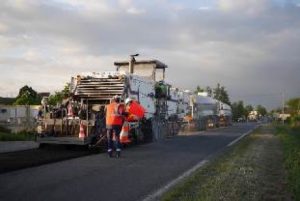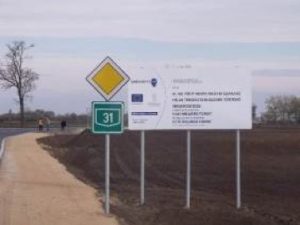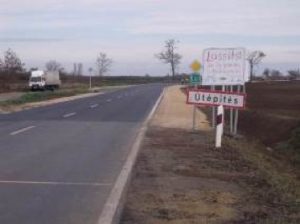1 – Updating the LCI and LCA for hot mix asphalt
The LCA was used to produce a PCR (product category rules) available in the whole Europe.
Regarding the environmental parameters in Action C1, a study has been performed and translated in English. It is available on USIRF website in French and in English. The LCI and LCA were used in European Standardization (CEN TC227/WG6). Besides the French LCA was finalized and translated in English. Document can be downloaded here.
2 – Production of the EPD for hot mix asphalt
New LCI and LCA allowed the consortium to produce a document named PCR (Product Category Rules), which is a methodology to make the environmental products declarations (EPD). The EPDs are to become obligatory regarding the Construction Products European Regulatory. Document can be downloaded here.
3 – A study for the health and safety of workers
Hazard assessment was performed to produce specific measurements of PAH (polycyclic aromatic hydrocarbons) on different configurations of jobsite. Two goals for this study: the values of PAH are needed to establish the LCA as part of impacts in the air and may be used to adapt the protection to the risk for health and safety for workers in jobsites. The study can be downloaded here.
4 – Activities and demonstrator jobsites:
France:
A meeting in Bordeaux near the future demonstrator took place in May 2015 (see figure below), about the instrumentation of worksites and asphalt plants. A second meeting took place on 15th and 16th September 2015 in Lyon and Clermont-Ferrand.
The French example presented below describes the cold in-place recycling with bitumen emulsion technique applied on a section of Departmental Road (RD) 1089, formerly National Road (RN) 89 (Bordeaux – Lyon) in the Gironde Department, linking the Dordogne border in the north to highway A89 at Bordeaux.
Worksite started on May 4 (2015) and included 10 days of cold in-place recycling with bitumen emulsion carried out at night during weeks 19, 20, 21 and 22. A curing period of 3 weeks of the cold in-place recycling technique material had to be observed before applying the wearing course during weeks 24, 25 and 26. The main objective was ensuring that the final road commissioning occurred before the first weekend of July at the start of the holiday season, to avoid disrupting the heavy traffic of this region.
Hungary:
The demonstration site was chosen in August 2015 and is the Road Number 31. The infrastructure section was the renovation of Road Number 31 in the country of Heves located in the North East Hungary on the edge of the Alföld (the Hungarian Great Plain). The road was constructed by Colas Út Zrt.
On February 2016, the Hungarian team completed the data collection for field validation of the LIFE SustainEuroRoad project. Main activities developed by the Hungarian team were to control the fuel consumption, power consumption and delivery distance during the asphalt mixture production and the road construction.
From the technical perspective the constructed pavement structure was composed of four layers with the following measures:
- Wearing course: 4 cm AC 11 (mF)
- Binding course: 9 cm AC 22 (mF)
- Subbase layer with hydraulic bound mixture: 20 cm CKt-4
- 20 cm cold recycling on the exhausted pavement
The Hungarian experts worked during 3 different construction days for the deployment of every layer and subsequently collected all the data during the construction process. Data and info collected have been submitted to USIRF, project coordinator, in order to refine the thermal model (Energy calculation method) of the SEVE software. Specifically, a comparison will be completed on a like-for- like basis between:
- Parameters measured on site
- Parameters simulated on SEVE
Figure: Road Number 31, Hungary, August 2015
Germany:
The first meeting took place in Bottrop in October 2015.
Then the roadbuilding activities in Berlin, Hamburg and the Ruhr region were considered. At the end, the decision was taken for the Ruhr region and its periphery. In discussion with Eurovia Teerbau GmbH’s Bottrop Branch Manager, two highways activities were selected.
The first activity focused on the Federal highway A2, one of the main traffic arteries in the Federal Republic of Germany. A2 is a dual, three-lane highway which runs in the east-west direction. In this section, the emergency lane and the load lane was renovated in the easterly direction. The supporting layer, binding layer and covering layer was renovated in this roadbuilding project over a length of about 10 km. An AC 32 T S, an SMA 16 B S and an AC 5 DSH-V were used here. These roadbuilding activities were supplied by altogether three different mixing plants.
The second activity was deployed in the area of the Federal A40 highway, which is also heavily trafficked in the Ruhr region. The A40 is a dual two-lane highway running in the east-west direction. In this project, with full blocking of the relevant driving directions over two weekends, the binding layer and cover layer were planned and then rebuilt. An AC 22 B S and a SMA 8 S were used. Four different mixing plants delivered to this roadbuilding site. The asphalt addition was done sometimes in parallel to the milling work.
Spain:
Regarding Spain, as expected, four asphalt plants were included in the validation test. Each plant can include more than one job site. In Spain, even more, it is foreseen a bigger road rehabilitation program (mainly by the Ministry of Publics Works) that will ease the selection of the job sites. It is our aim to include as many variables as possible in order to enrich information from each asphalt plant and job sites.
All parameters, which will be controlled in the asphalt plants and in the job sites in order to generate a data base, which can be compared to data coming from SEVE experience, were defined.
The 5 sites, which experienced already a first round of data, are the following:
- BECSA Plant sited in Castellón
- PAVASAL Plant sited in Cheste (Valencia)
- EIFFAGE INFRAESTRUCTURAS Plant sited in Malaga (2 sites)
- EIFFAGE INFRAESTRUCTURAS Plant sited in Sevilla
The technical team responsible for the asphalt plants has been informed in detail of the purpose of the project and they were explained in detail how the SEVE information is collected.
The reasons why these plants were chosen are as follows:
- These plants normally have a guaranteed production. It has already been mentioned that currently the Spanish market of bituminous mixtures is passing through a critical moment because of the scarcity of works, so that the selection of collaborating companies and project was done thinking of having some that could guarantee the outlet data more or less continuously, so that the information collected could be relevant,
- BECSA was the first Spanish company that has developed an environmental product declaration. They therefore have experience in the treatment of life-cycle assessment.
- PAVASAL has previously worked in the environmental analysis of asphalt mixtures, so their information is very valuable. Especially noteworthy are collecting information on the use of RAP in the manufacture of asphalt mixtures and the potential impact on emissions in the manufacturing process,
- EIFFAGE INFRAESTRUCTURAS is the largest manufacturer consortium of bituminous mixtures in Spain, which has a remarkable technological capacity. They have experience handling SEVE and they have used this tool to supervise a work with half-warm asphalt mixes in Córdoba (Spain).
BECSA has already provided part of the information required and the other three asphalt plants provide that information at the beginning of the summer.
In parallel with the work being carried out in each of the asphalt plants, ASEFMA staff involved in the project has been collecting information on environmental impact analysis of bituminous mixtures carried out in Spain.
During this collection process, ASEFMA has established an advisory agreement and collaboration with the Technological Center CARTIF since they are one of the most experienced organisations on life-cycle assessment for road construction. According to his information, the average impact of the various stages of manufacture, are as follows in Figure 5:
Figure 1: Average impact of the various stages of manufacture
These data confirm the choice made on data collection coming from asphalt plants.
In parallel there has been an intensive search for data of environmental impact analysis undertaken in other projects or organizations to compare them with data collected experimentally in the SustainEuroRoad project and to have a broader validation data received criterion.
More tasks related to data collection of environmental impact were as follows:
- There are for the moment no data on environmental impact of aggregates production. For this reason ASEFMA has addressed the association representing manufacturers of aggregates (Anefa). The response received is that there is hardly any sectoral interest in carrying out this assessment and as baseline data refers to the work being carried out in the WG 13 of CEN / TC 154, where they are preparing a document on product category rules that will serve as the EPD’s support,
- It has been sought an update on how to allocate the impacts associated to steel slags. ASEFMA has contacted the Steel Technology Platform where various options have been discussed about the accounting of impacts. His final proposal has two alternatives: an allocation based on energy criteria and another based on economic criteria.
Following this work, we have found that the information provided may be especially interesting to start collaboration with the Diputación Foral of Guipuzcoa which is carrying out a job evaluation on the use of steel slag in road construction. More details are to be found under the action D4 presentation.
All these demonstrators were constituted by the construction or the maintenance of a portion of road, with manufacturing and laying of products and traditional techniques compared to virtuous techniques and products for the environment, with the same technical quality.
Then, the following controlling activities were performed:
- Emissions of asphalt plants, quarries, transport elements and laying machinery
- Fuel consumption during the operation to verify the theoretical values provided by the machinery producers
- Statistical control of asphalt plants in terms of fuel and electricity consumption to validate the thermal models and to separate clearly the effects due to the start and stop operations
These measurements made during manufacturing of materials (bituminous mixes in asphalt plant or in a specific machine in situ) were compared with the issues of the software SEVE.
These comparisons allowed validating data in the different versions of the software.
Demonstrators allowed putting in place best practices and shared know-how between the 4 countries. Of course, they also allowed finalizing the software.
5 – Software SEVE-TP in 5 languages:
Five versions of a software SEVE-TP in 5 languages:
- English version: Http:\\international3.seve-tp.com
- Spanish version: Http:\\spanish.seve-tp.com
- Hungarian version: Http:\\hungarian.seve-tp.com
- German version: Http:\\german.seve-tp.com
- French version: Http://www.seve-tp.com
6 – Methodology and sources for SEVE-TP :
At the end of the project, with SustainEuroRoad, a report details the methodology used and the sources of data to produce the different software. Document can be downloaded here.
7 – Some results issued of the different versions of the software SEVE :
At the end of the project, with SustainEuroRoad, we can have the following results:
- France (Bordeaux): the bonus between a traditional technique and an eco-friendly technique may reach:
- Energy: 75.5 %
- GHG: 74.4 %
- Saving of materials (aggregates): 90.7 %
Report can be downloaded here.
- Hungary (Heves County): the bonus between a traditional technique and an eco-friendly technique may reach:
- Energy: 37.6 %
- GHG: 0 %
- Saving of materials (aggregates): 64.2 %
Report can be downloaded here.
- Spain (Madrid): the bonus between a traditional technique and an eco-friendly technique may reach:
- Energy: 30%
- GHG: 30.2 %
- Saving of materials (aggregates): 41.4 %
Report can be downloaded here.
- Germany (Bergkamen): the bonus between a traditional technique and an eco-friendly technique may reach:
- Energy: 37.7 %
- GHG: 38.0 %
- Saving of materials (aggregates): 57.4 %
Report can be downloaded here.
Should you need further information, please contact our experts:
- France : Christine Leroy- [email protected]
- Spain : José-Luis PEÑA – [email protected]
- Hungary : Gábor ROSZIK – [email protected]
- Europe : José DIEZ – [email protected]




